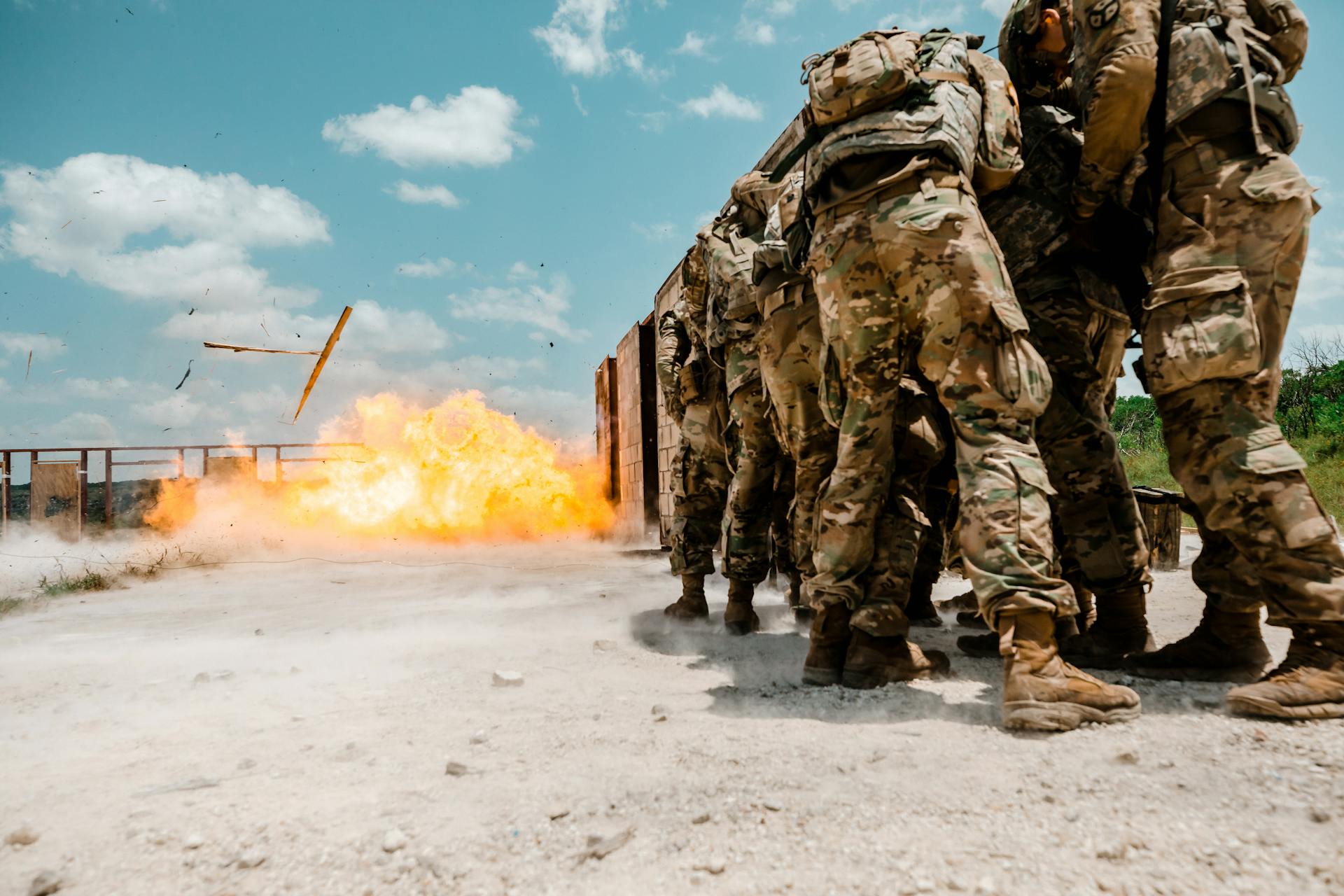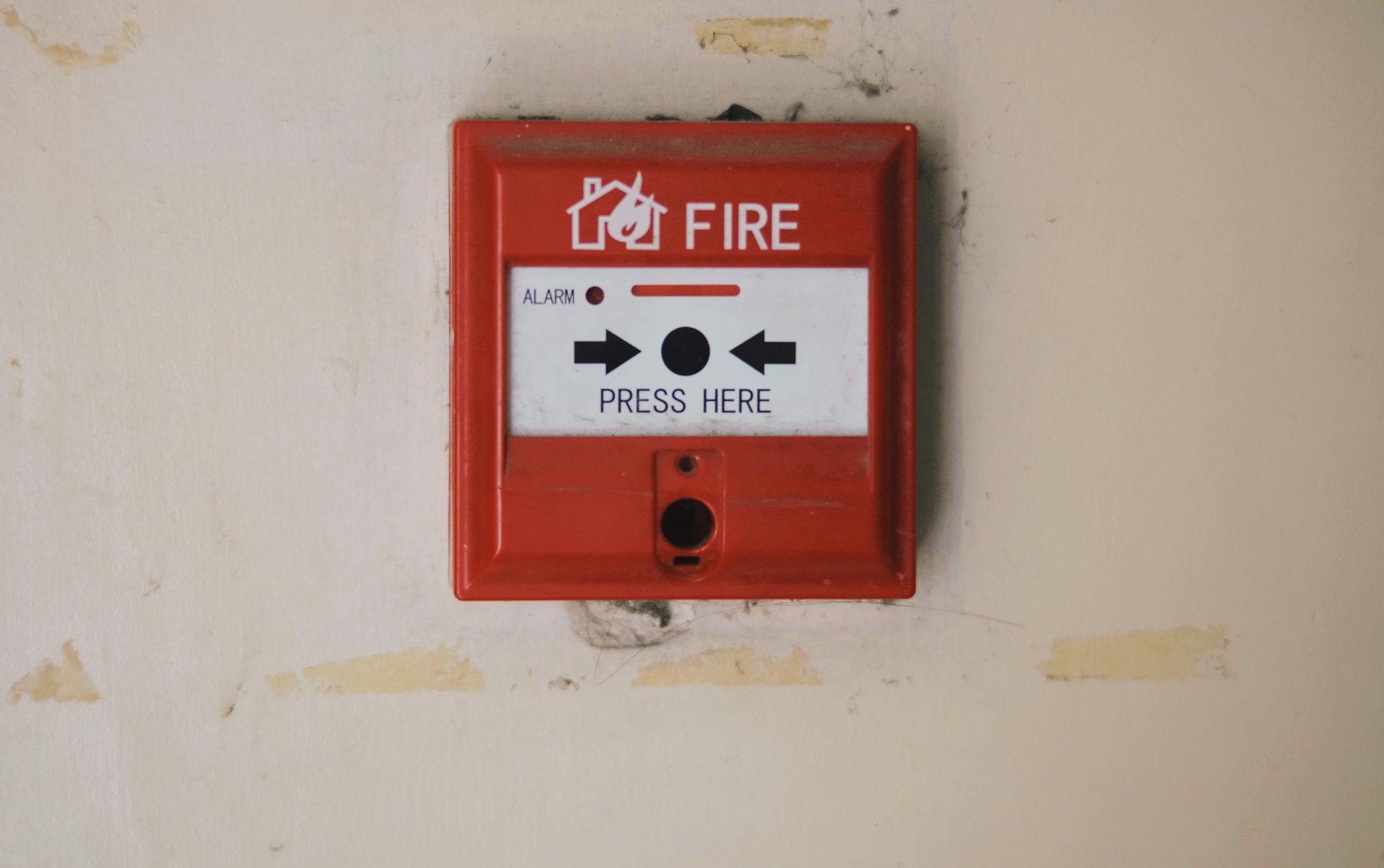
Service dogs are trained to detect seizures by learning to recognize subtle changes in their owner's behavior and physical condition. They can pick up on these cues even before the owner is aware of them.
A service dog's keen sense of smell is also a valuable asset in detecting seizures. They can detect changes in their owner's scent, such as a drop in blood sugar levels, which can trigger a seizure.
By recognizing these early warning signs, service dogs can alert their owners to take action, such as taking medication or finding a safe place to sit or lie down. This can help prevent injuries and reduce the severity of seizures.
Service dogs are trained to respond to seizures in a calm and gentle manner, never causing more harm than good.
Discover more: Maltese Dogs and Seizures
What Are Service Dogs
Service dogs are highly trained canines that assist individuals with disabilities, including those who experience seizures. They're not pets, but rather working animals that undergo extensive training to perform specific tasks.
Service dogs are trained to detect changes in their handler's behavior, such as unusual breathing patterns or changes in body temperature, which can indicate an impending seizure.
Training a Service Dog
Training a service dog requires patience, consistency, and positive reinforcement techniques. Positive reinforcement involves rewarding desired behaviors with treats, praise, or toys, reinforcing the dog's understanding of what is expected of them.
Clicker training, a form of operant conditioning, is often used in conjunction with positive reinforcement to mark desired behaviors with a distinct sound, typically from a handheld clicker device. This method is commonly utilized in self-training programs.
To train a seizure alert service dog, you'll need to teach them to recognize seizure signs, alert their handler, find help, and provide comfort. Here's a step-by-step guide to training tasks:
- Recognizing Seizure Signs: Teach the dog to recognize the specific signs or cues associated with an impending seizure in their handler.
- Alerting: Teach the dog to alert their handler by using a specific behavior, such as nudging or pawing.
- Finding Help: Train the dog to seek assistance from nearby individuals in the event of a seizure.
- Providing Comfort: Teach the dog to provide comfort and support to their handler during and after a seizure episode.
Maintenance training is crucial to keep the dog proficient in their tasks. Regular training sessions, practice scenarios, and occasional refresher courses will keep the dog sharp and responsive.
Trainer/Training Organization
Working with a trainer or training organization can be a great way to get a seizure alert service dog. These organizations specialize in breeding, raising, and training service dogs for various purposes.
Trainer or training organizations employ professional trainers who use structured programs to train dogs to perform specific tasks tailored to individual needs. The process typically involves an application and assessment process to match handlers with suitable dogs.
The dog undergoes intensive training, often lasting several months, to ensure proficiency in seizure alert tasks. This method may involve a waiting period and financial investment, but it offers the assurance of working with experienced professionals.
Assistance Dog International (ADI) is a great resource to locate an ADI credentialed trainer in your area.
You might like: How to Become a Dog Trainer for Service Dogs
Train Your Dog
Training a service dog like a seizure alert dog requires patience, consistency, and positive reinforcement techniques. Positive reinforcement involves rewarding desired behaviors with treats, praise, or toys, reinforcing the dog's understanding of what is expected of them.
You can teach your dog to recognize seizure signs by starting with subtle changes in behavior, scent, or body language. This may include changes in pupillary changes or slight tremors.
Here's an interesting read: Positive Reinforcement Dog Training
To alert their handler, dogs can be taught to use a specific behavior, such as nudging or pawing. This behavior should be consistent and clear, so the handler knows what to expect.
Dogs can be trained to seek assistance from nearby individuals in the event of a seizure. This may involve leading someone back to the handler or retrieving a phone or medical alert device.
To maintain proficiency in their tasks, continue training and reinforcing desired behaviors throughout the dog's life. Incorporate regular training sessions, practice scenarios, and occasional refresher courses to keep the dog sharp and responsive.
Here are some key steps to follow when training a seizure alert dog:
- Recognize seizure signs and teach your dog to identify them.
- Train your dog to alert their handler using a specific behavior.
- Teach your dog to seek assistance from nearby individuals.
- Train your dog to provide comfort and support during and after a seizure episode.
With dedication and consistency, you can train your dog to be a valuable seizure alert service dog.
Choosing a Dog
Temperament is a crucial factor to consider when selecting a dog for seizure alert service work. A dog with a calm and gentle nature is well-suited for this type of role.
You'll want to assess the individual needs and lifestyle of the handler to ensure a suitable match. This includes considering factors such as energy level and health.
A dog with a moderate energy level is often a good fit for seizure alert service work, as they are able to keep up with their handler's lifestyle while also having enough energy to perform their duties.
It's essential to select a dog that is healthy and has a long lifespan, as this will allow them to provide years of reliable service to their handler.
Consider reading: How Do I Become a Search and Rescue Dog Handler
Service Dogs and Regulations
Service dogs play a vital role in assisting individuals with disabilities, including those who experience seizures.
In the United States, the Americans with Disabilities Act (ADA) requires businesses and public spaces to allow service dogs, including those trained to detect seizures.
Service dogs are protected under the Fair Housing Act, which prohibits landlords from denying housing to individuals with disabilities.
These laws apply to all types of service dogs, including those trained to detect seizures.
Service dogs must be trained to behave well in public and must be under the control of their handler at all times.
For more insights, see: Lifespan of a Dog with Seizures
How Service Dogs Detect Seizures
Service dogs can detect seizures by recognizing subtle behavioral and physiological changes in their handlers. These changes can vary widely from person to person.
One of the ways seizure alert service dogs detect seizures is by recognizing altered scent. This is because the body's physiological changes before a seizure can be detected through scent.
Seizure alert service dogs are trained to recognize changes in body language that signal an impending seizure. This can include changes in posture, facial expressions, or other nonverbal cues.
Electrical changes in the brain can also be detected by seizure alert service dogs. This is a complex process that requires specialized training and sensitivity.
These dogs can provide invaluable assistance and support during and after a seizure episode.
Check this out: Medical Dog Training
Work Breeds and Response Dogs
Seizure response dogs are trained to assist individuals during and after a seizure, but they don't predict one. They can help by placing the person in a position that helps them breathe better, getting help, guiding the person to a preset safe location, or helping them regain their balance.
Related reading: Dog Behaviour after Seizure
Some breeds are often preferred for seizure alert service work due to their temperament and physical attributes. Labrador Retrievers are known for their gentle nature and high intelligence, making them a popular choice for this role. Golden Retrievers possess a similar combination of traits, including loyalty and a gentle disposition.
Breeds like Standard Poodles and Border Collies are also well-suited for seizure alert work due to their intelligence, trainability, and work ethic. Here are some commonly selected breeds for seizure alert service work:
Work Breeds
Labrador Retrievers are often used as service dogs in seizure alert work due to their gentle nature and high intelligence. Their calm demeanor makes them an excellent choice for this role.
Golden Retrievers possess the ideal combination of intelligence, loyalty, and gentle disposition, making them excellent candidates for service work.
Standard Poodles are highly intelligent and trainable, with a hypoallergenic coat that may be beneficial for individuals with allergies.
Border Collies excel in tasks that require precision and focus, such as alerting to seizures, due to their renowned intelligence and work ethic.
Some popular work breeds include:
- Labrador Retrievers
- Golden Retrievers
- Standard Poodles
- Border Collies
Response Dogs vs
Seizure response dogs are a crucial part of supporting individuals with epilepsy. They assist during and after a seizure, but don't predict one.
Seizure response dogs can place the person in a position that helps them breathe better, get help, guide the person to a preset safe location, or help them regain their balance. This is especially important because seizures can have significant repercussions.
About 67 to 100 percent of seizure response dogs are accurate in their assistance, as found in a 2019 article published in Scientific Reports. This high accuracy rate is crucial in helping individuals with epilepsy.
Seizure response dogs are often trained to be seizure response dogs because supporting people through and after seizures is crucial. They work in conjunction with seizure alert dogs to provide comprehensive support.
Seizure response dogs can be trained to perform multiple tasks, including getting help, guiding the person to a safe location, and helping them regain their balance. This is vital in ensuring the individual's safety and well-being.
For your interest: Medical Response Dog
Sources
- https://epilepsyfoundation.org.au/understanding-epilepsy/epilepsy-and-seizure-management-tools/seizure-alert-dogs/
- https://www.servicedogcertifications.org/what-is-a-seizure-alert-dog/
- https://www.psychologytoday.com/us/blog/canine-corner/202103/how-do-seizure-alert-dogs-know-seizure-is-coming
- https://www.nsarco.com/seizure-alert-service-dogs/
- https://www.nationalgeographic.com/animals/article/seizure-dogs-save-humans
Featured Images: pexels.com


